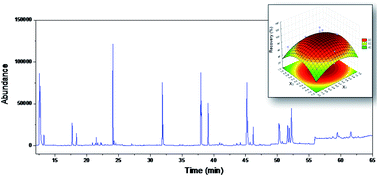Box–Behnken design applied to ultrasound-assisted extraction for the determination of polycyclic aromatic hydrocarbons in river sediments by gas chromatography/mass spectrometry
Abstract
This paper describes the optimization of the extraction of polycyclic aromatic hydrocarbons (PAHs) in sediment samples from a river by applying an ultrasonic bath for quantification by gas chromatography/mass spectrometry (GC/MS). The factors n-hexane and dichloromethane proportion in the solvent mixture, solvent mixture volume and sonication time were optimized to take into account a 33 Box–Behnken design with a triplicate central point. The optimum extraction conditions achieved through a response surface methodology study consisted of 15 minutes of sonication time and 10 mL of solvent mixture composed of 55% of n-hexane. The optimized conditions were validated by assessing the percentage recovery obtained for the blank spike and the sample spike using n-hexane–dichloromethane (55 : 45) and n-hexane–acetone (55 : 45) as solvent mixtures. The extraction with n-hexane–acetone (55 : 45) presented lower percent relative standard deviation and greater efficiency in the extraction process, since hexane–acetone (55 : 45) led to higher mean percentages of recovery of the blank spike and the sample spike.

- This article is part of the themed collection: Analytical Sciences in Brazil

 Please wait while we load your content...
Please wait while we load your content...